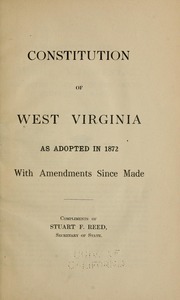Chapter 1: Education in colonial times
Chapter 2: Post-Revolution Education
Chapter 3: The Civil War and West Virginia Statehood
Chapter 4: Education System under the 1872 Constitution
Chapter 5: Era of Transformation, 1880-1909
Chapter 6 1909-1932: The Age of Uniformity & the Battle Between Old School and Progressive Education
Chapter 7 1933-1950: Education under the county unit, the Great Depression, WWII and Beyond
Chapter 4: Education System under the 1872 Constitution

While the system was rife with problems, as outlined above, there were still great strides made in establishing a free school system in the new state. From 1869 to 1870 alone, enrollment jumped by forty percent. That year,495 schoolhouses were built . In 1865-66 the average term length was 2.7 months. By 1869-70 it increased to 4.1 months. After the Radicals were defeated and Democrats wrote a new constitution, the school system underwent more changes.
The Democrats gained control of the state government in 1870. They repealed the disenfranchisement of ex-Confederates. Reorganizing the government, however, did not stop there. Soon they made calls for a constitutional convention, led by many ex-Confederates. There was concern this new constitution would abolish the free school system. However, those fears were unwarranted as Article XII perpetuated “a thorough and efficient system of free schools.” A few changes were made to the system. First, the county district system was adopted instead of townships. The General Superintendent was changed to a State Superintendent of Schools, elected for a four year term. No longer an appointed professional position, the job became politicized. Also a Board was created to manage the School Fund, which would be funded by the same sources as before.
Educational statutes were revised for the new system during the 1872-73 legislative sessions, and again in 1877, 1879, and 1881. These new laws retained county superintendents but tried to tweak local accountability by changing the number of trustees, and methods of gaining office. They also instituted fines for misuse of local levy funds. Overall, the financial burden to fund schools remained at the local level, with state taxes remaining at ten cents per $100 of property value, whereas district levy max was at fifty cents per $100 for both buildings and teacher salaries. This caused a system with varying levels of inequalities throughout the state and even within counties.
While the issue of funding was never effectively resolved throughout the state, strides were made by the legislature to standardize the certification of teachers. Until 1873, the power to certify teachers was vested in the county superintendent. That year, a law creating a three member county board for teacher certification was passed. Additionally, Normal Schools began issuing diploma certificates for teachers. While there was still flagrant issuance of certification in some places, the system was improving. By 1876, teacher institutes were implemented in each county and a law the following year required all teachers to attend a two-day district institute. In 1879 the legislature created three grades of certification, abolished the state board of examiners, and vested sole authority to issue certification to county boards chaired by superintendents. By the end of the decade the institutes were extended to five days. Additionally, attempts were made for uniformity in the adoption of textbooks throughout the state, with the State Board of Education selecting a pool of appropriate books which counties could use to select appropriate books for their school systems.
In short, the 1870s was a decade of attempted uniformity in the education system. Having had no free public school system at the time of the founding of the state in 1863, the strides made during these seventeen years, while not perfect, were still worthy of some praise. It was a trial and error process in creating an administrative apparatus which could retain local control over education, yet maintain sufficient oversight to prevent fraud and malfeasance. Perhaps most importantly, the people of West Virginia were eager to establish a school system for their children. Evidence of this can be seen in the growth of schools, mostly one-room schoolhouses, from the beginning of statehood to 1880 (See Appendix A).
Bibliography
Ambler, Charles H. A History of Education in West Virginia: From Early Colonial Times to 1949. Huntington: Standard Printing & Publishing Company. 1951.
Callahan, James Morton. Semi-Centennial History of West Virginia. Semi-Centennial Commission of West Virginia. Charleston, WV: Tribune Printing Co. Press. 1913.
"1872 Constitution." West Virginia Archives and History. 9 April 1872. http://www.wvculture.org/history/government/1872constitution.html
